Abstract
1. The behaviour of the vestibulo-ocular reflex (VOR) in man was examined using pseudo-random and sinusoidal whole-body angular-motion stimuli applied about the yaw axis by a servo-controlled turn-table. 2. The VOR response was assessed in four conditions; during fixation on a head-fixed target (HFT); during attempted fixation in the dark of an imagined head-fixed (IHFT) or earth-fixed target (IEFT) and in darkness (DRK) whilst performing an auditory discrimination task. 3. When the pseudo-random stimulus was composed of four sinusoids, the three lowest frequencies (0.11, 0.24 and 0.37 Hz) were maintained constant whilst the highest frequency (F4) was varied from 0.39 to 2.08 Hz. In darkness (DRK condition) and when imagining a head-fixed target (IHFT condition) the gain of slow-phase eye velocity was not significantly affected by the frequency of the highest-frequency component, although there were significant changes in the phase for the IHFT condition. 4. During fixation of a real head-fixed target (HFT condition), both the gain and phase of eye velocity were significantly modified by the frequency (F4) of the highest-frequency component. When F4 was 0.39 Hz, all frequency components had a low gain (mean 0.05), but as F4 was increased there was a significant (P less than 0.001) increase in gain for all three low-frequency components which reached a maximum (mean 0.17) when F4 was 2.08 Hz. However, the gain for the highest frequency component always remained comparable to that obtained in response to a single discrete sinusoid of the same frequency. 5. When the stimulus was composed of only two sinusoids a similar increase in gain of the lower-frequency (0.22 Hz) component was observed in the head-fixed target condition as the frequency of the higher-frequency component was increased from 0.39 to 2.78 Hz. However, VOR gain was not significantly modified by the frequency of the higher-frequency component when subjects imagined a head-fixed or earth-fixed target in darkness. 6. The findings indicate that high levels of VOR suppression can be achieved in the head-fixed target condition with pseudo-random stimuli when all frequency components are below 0.4 Hz. But if the highest-frequency component rises above 0.8 Hz, optimum suppression is confined to the highest-frequency component, whilst suppression of the low-frequency components is significantly reduced.(ABSTRACT TRUNCATED AT 400 WORDS)
Full text
PDF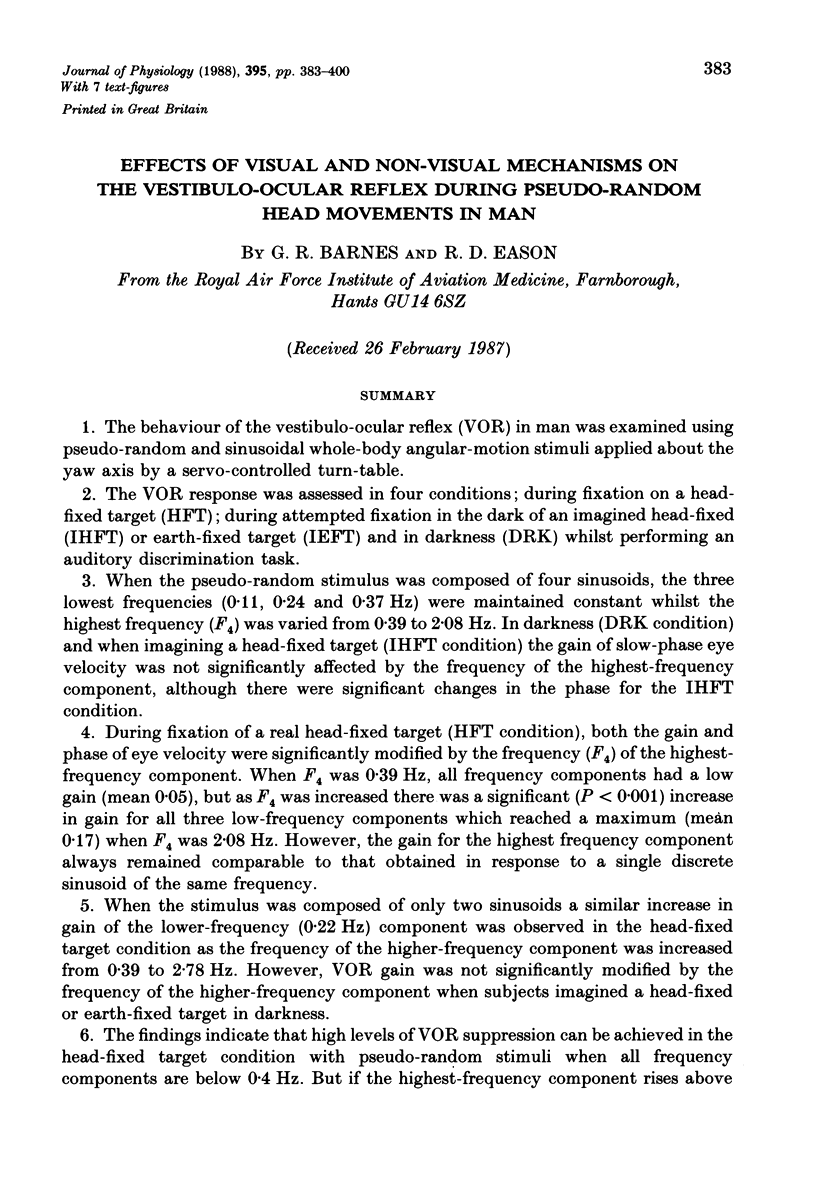
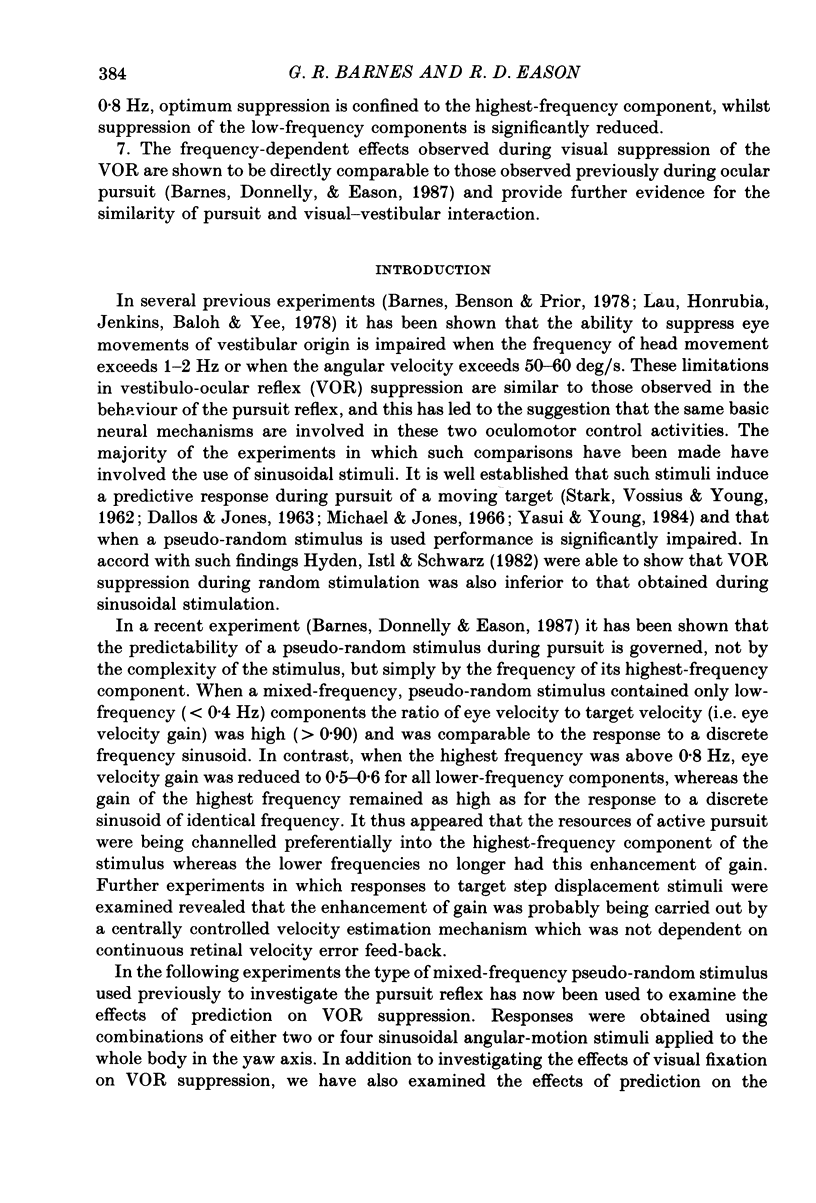
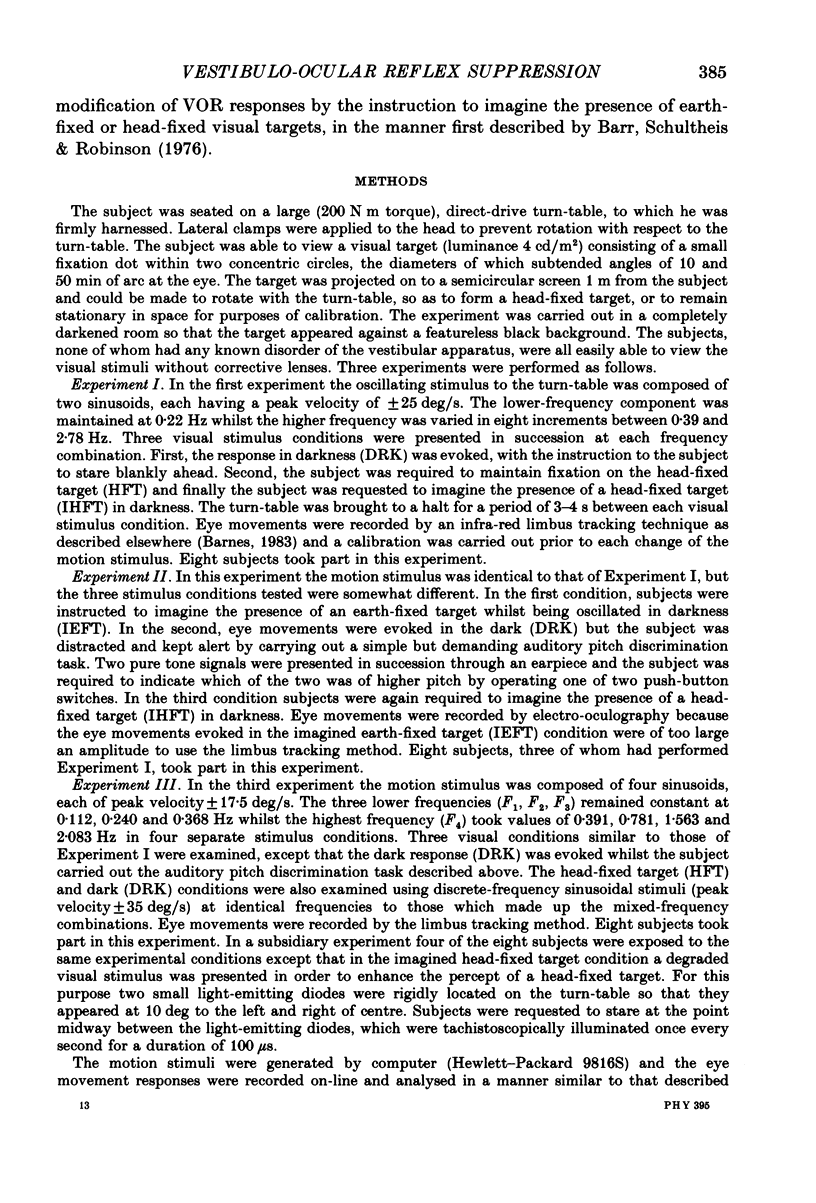
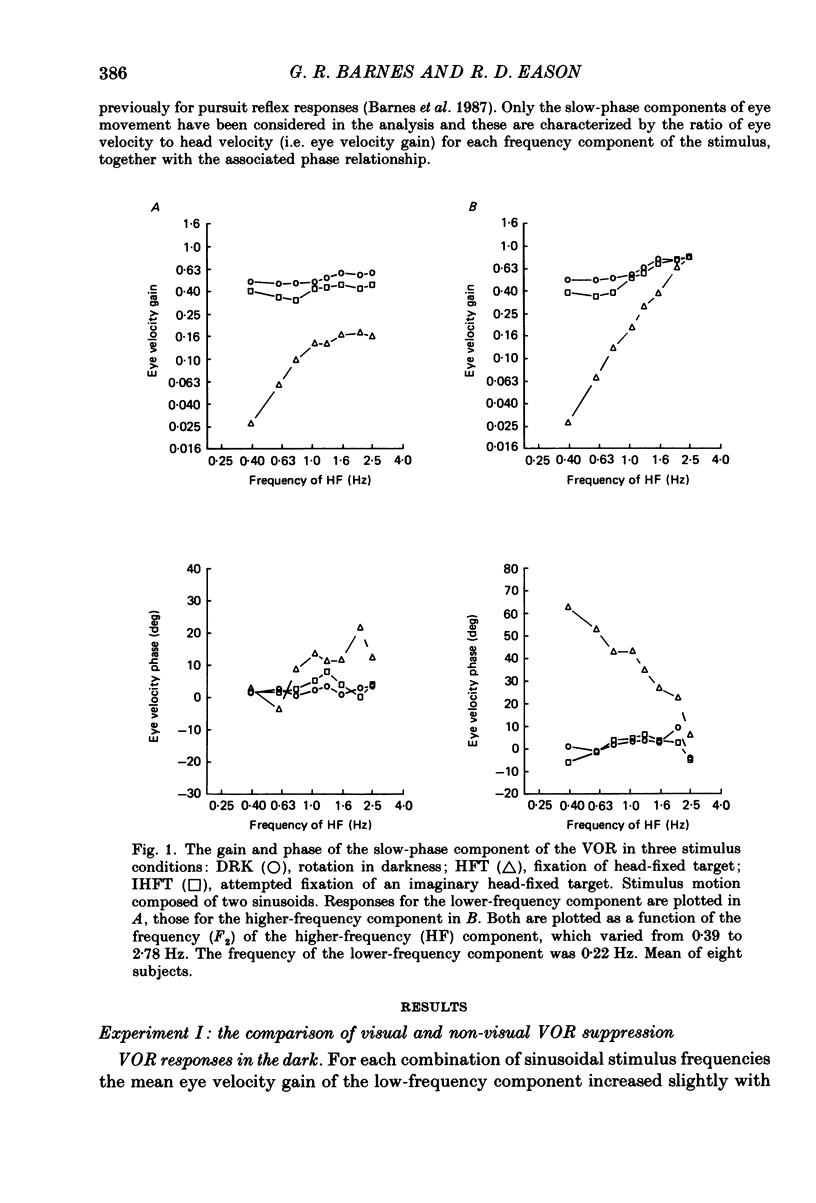
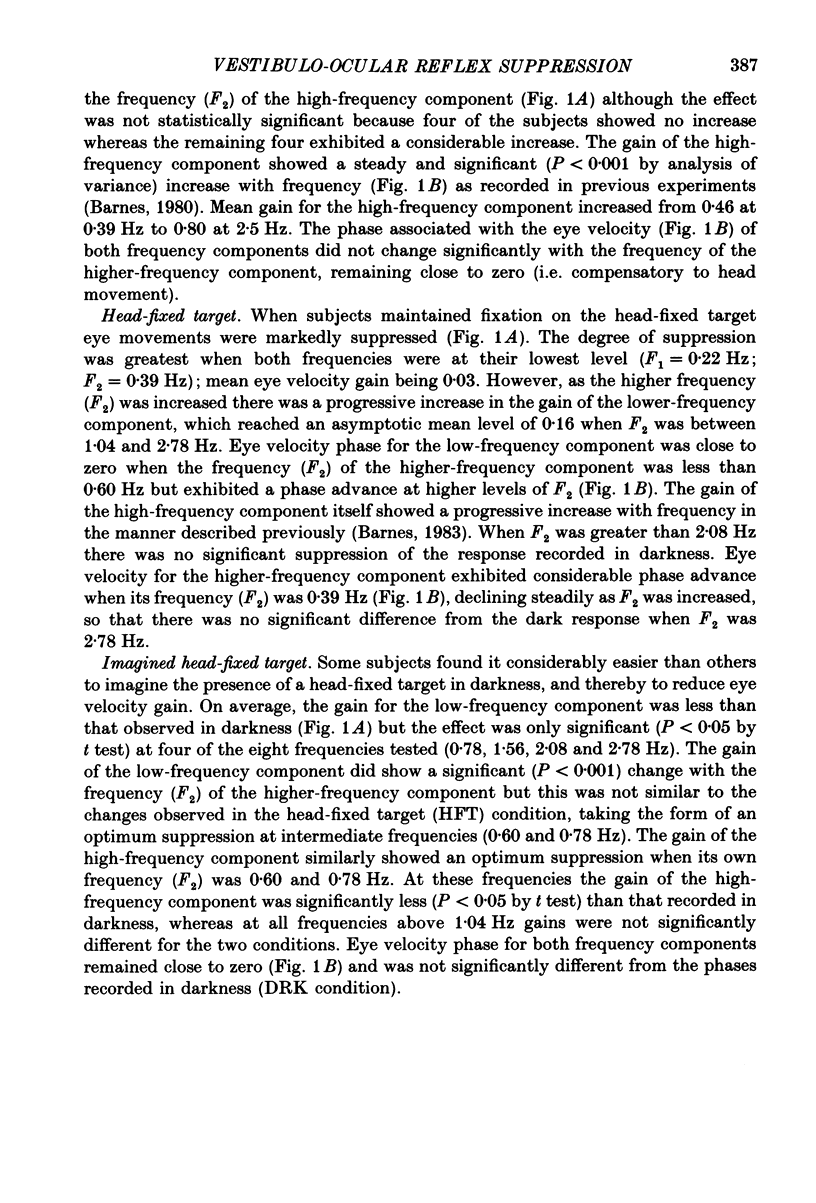
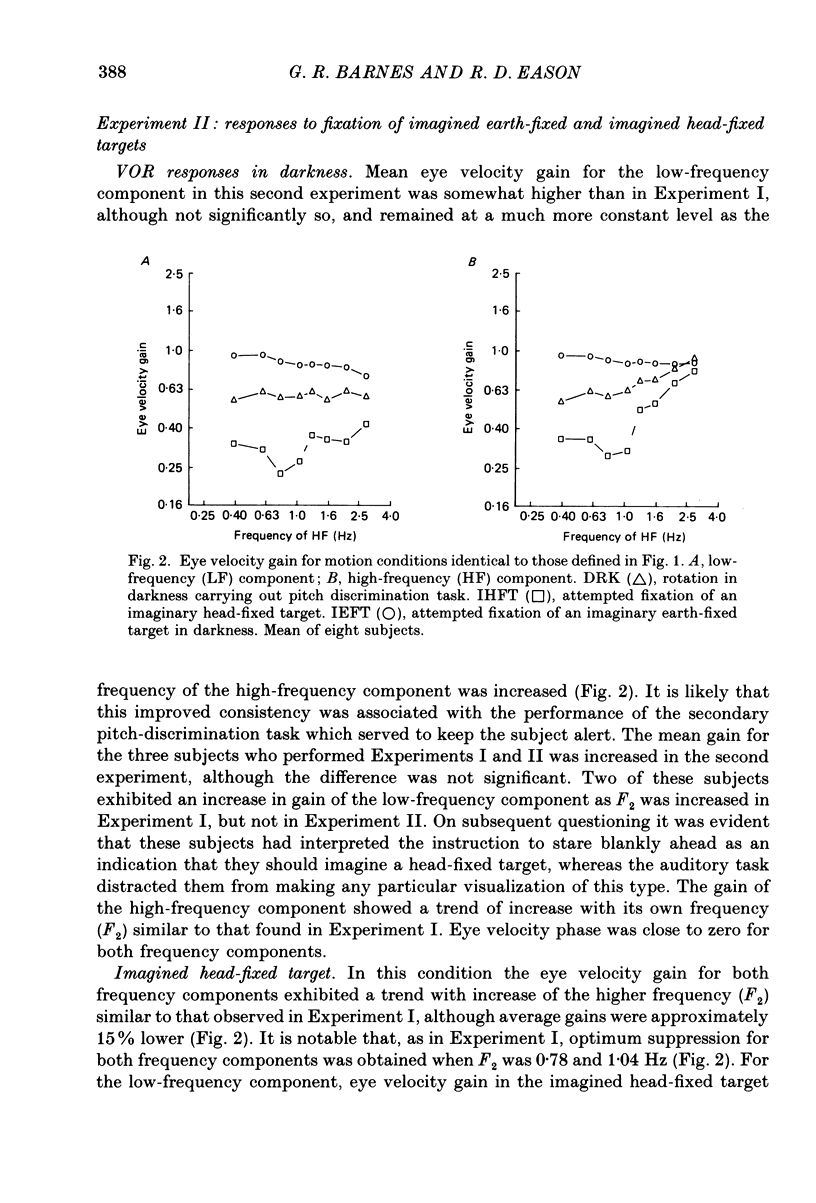

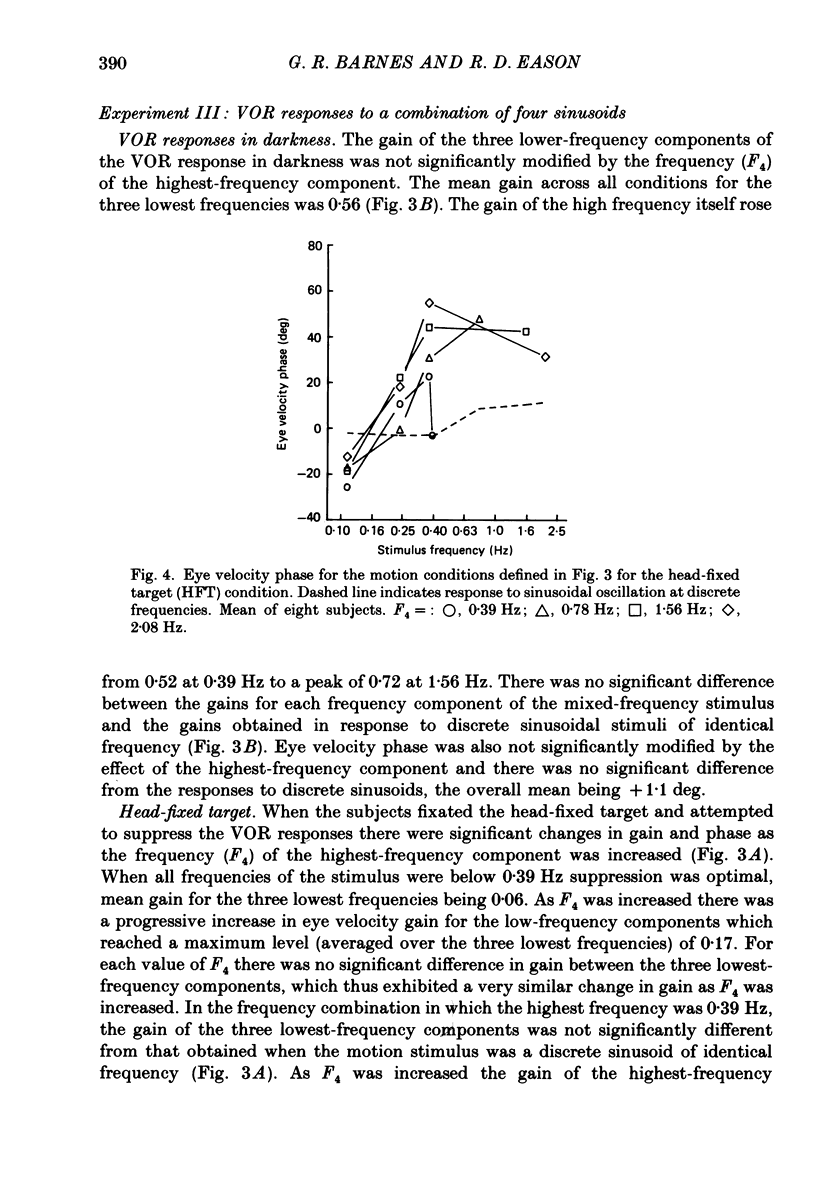

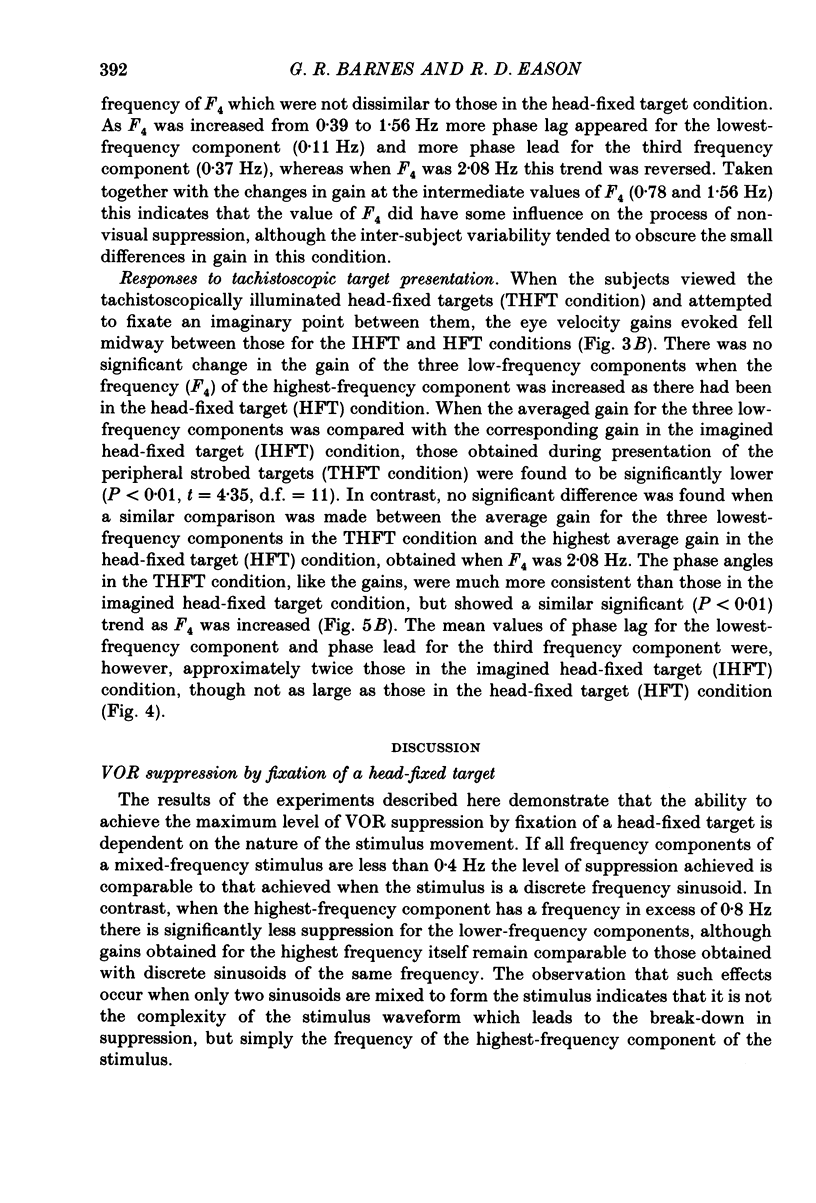
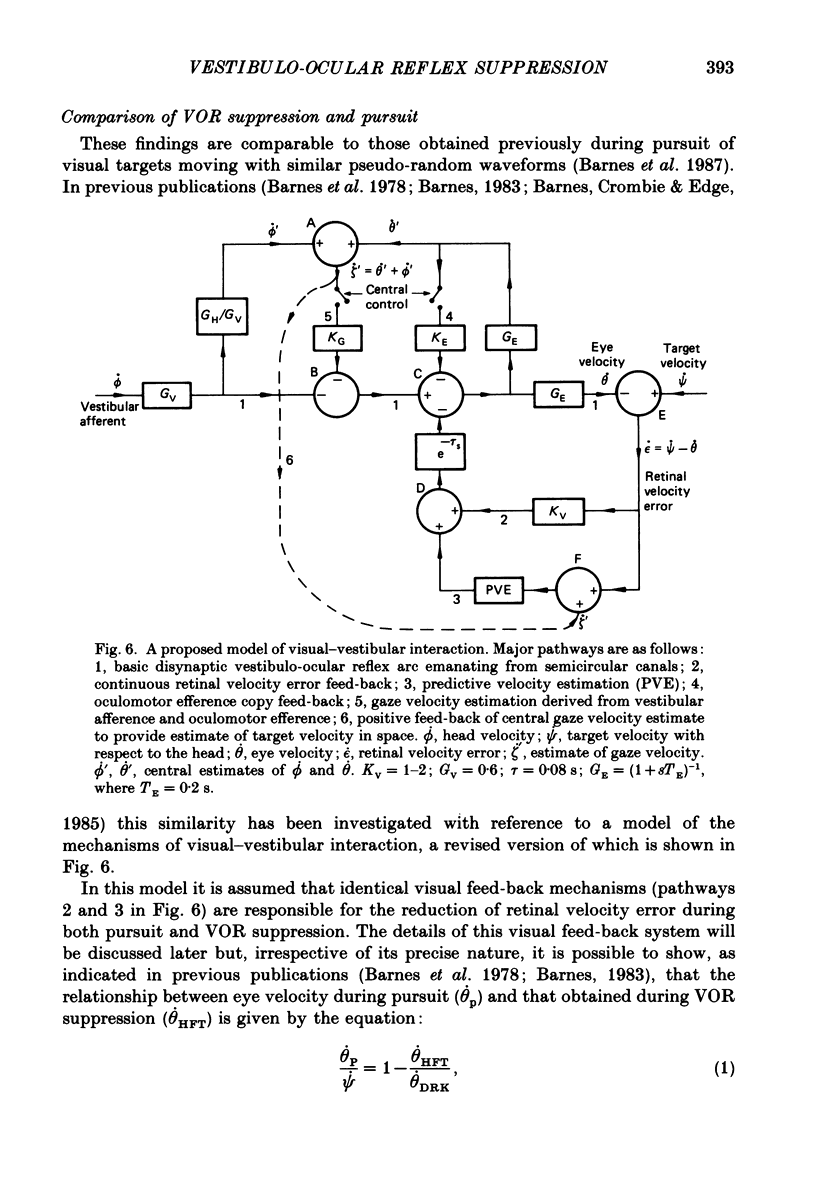
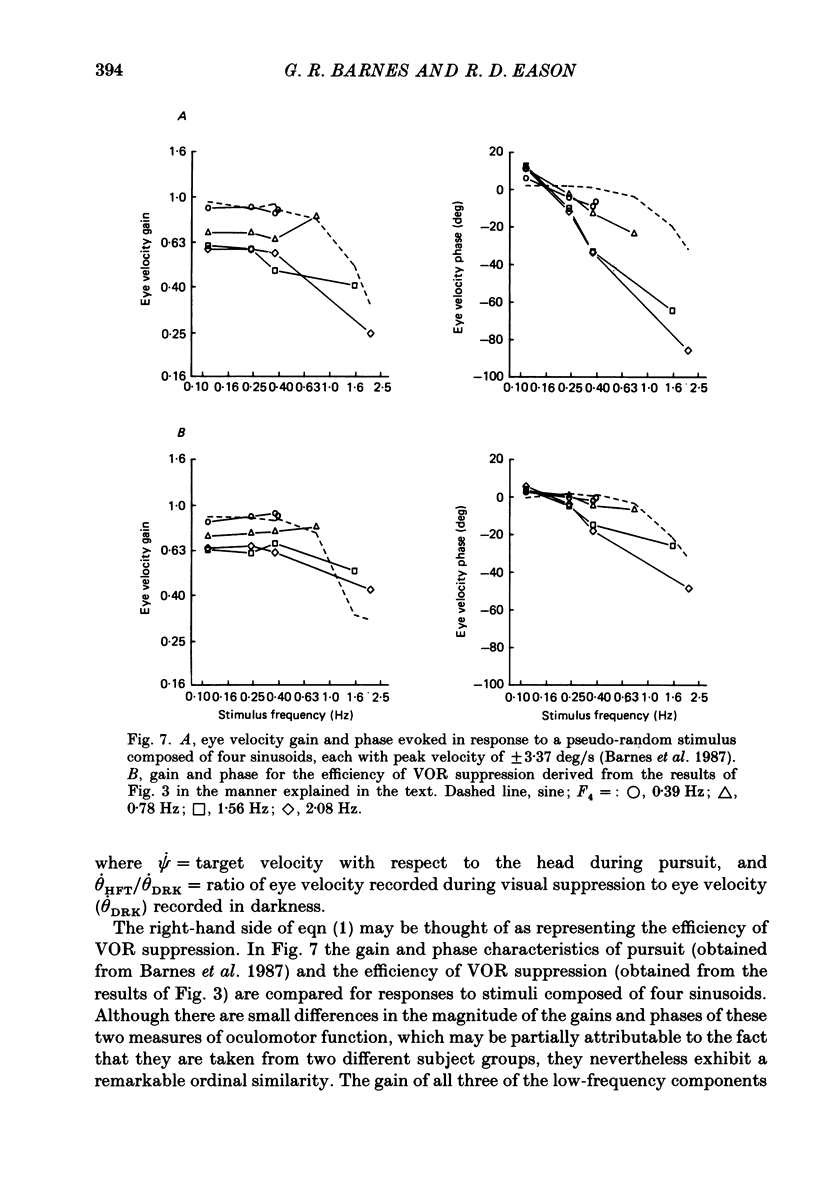
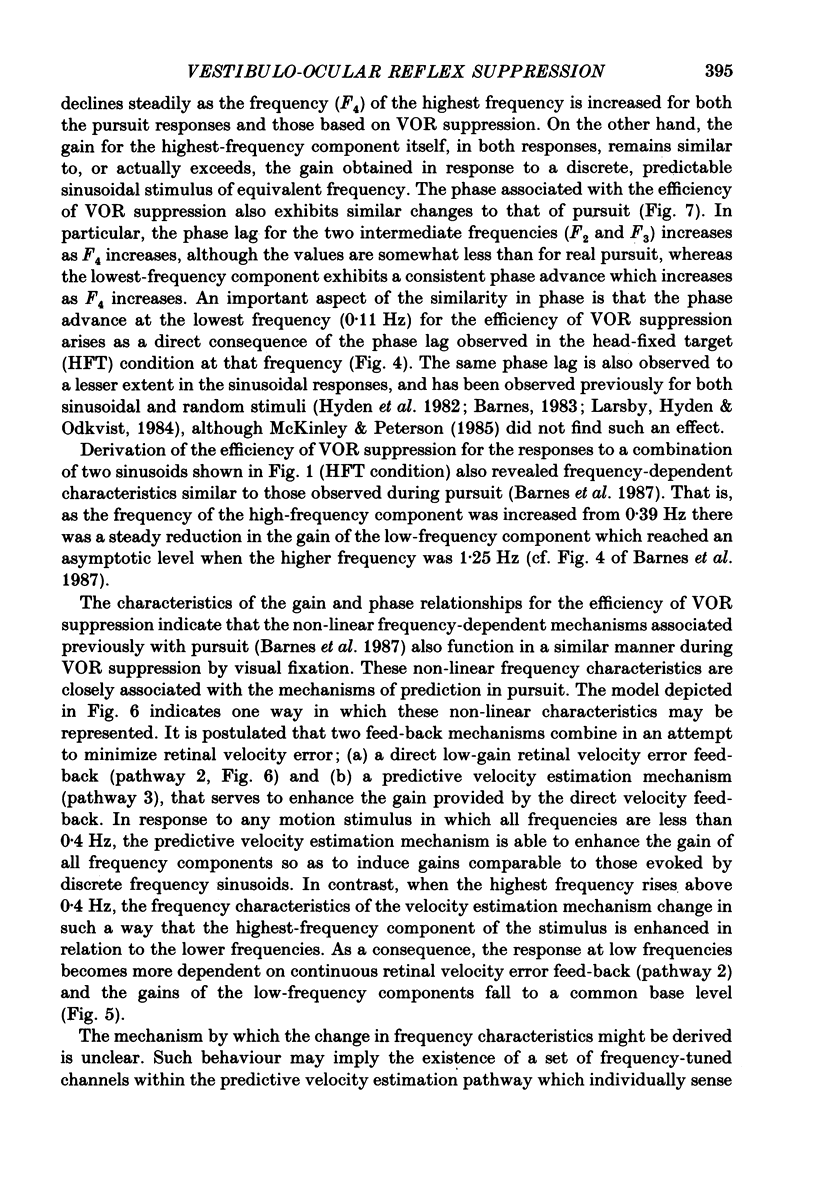


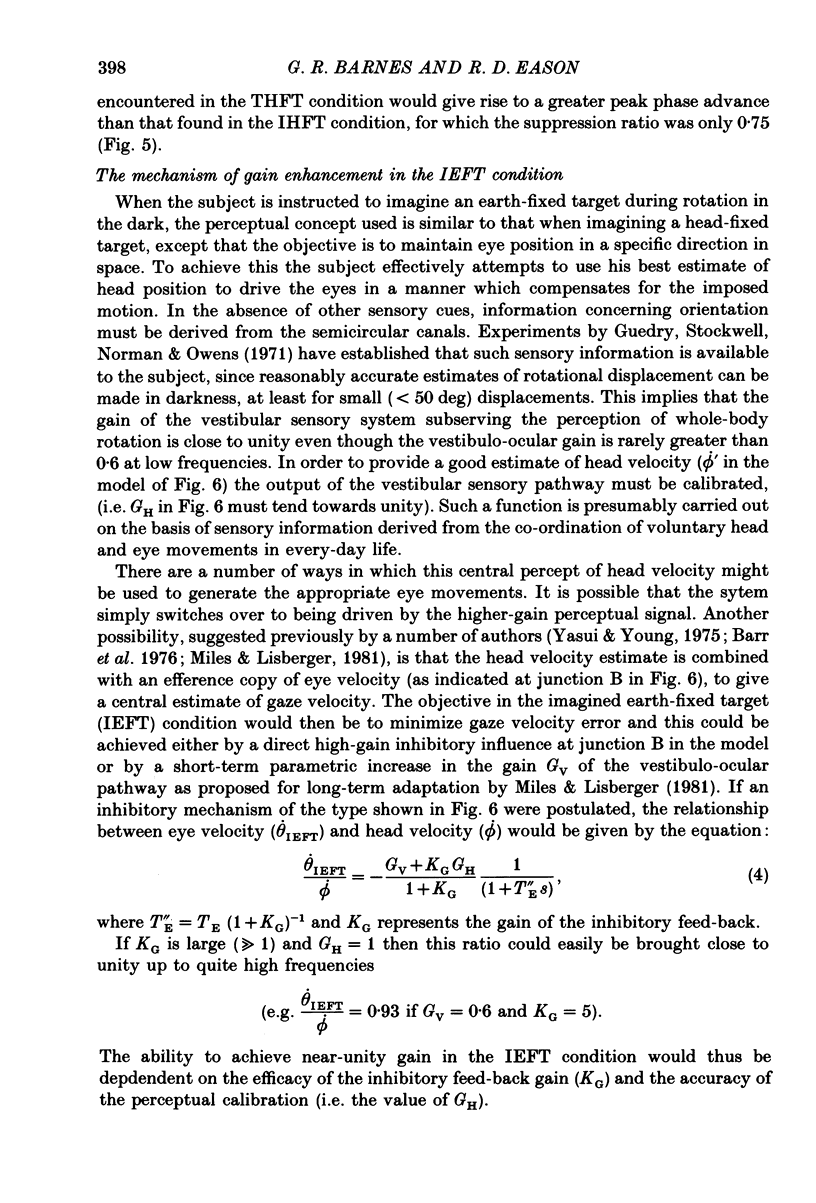
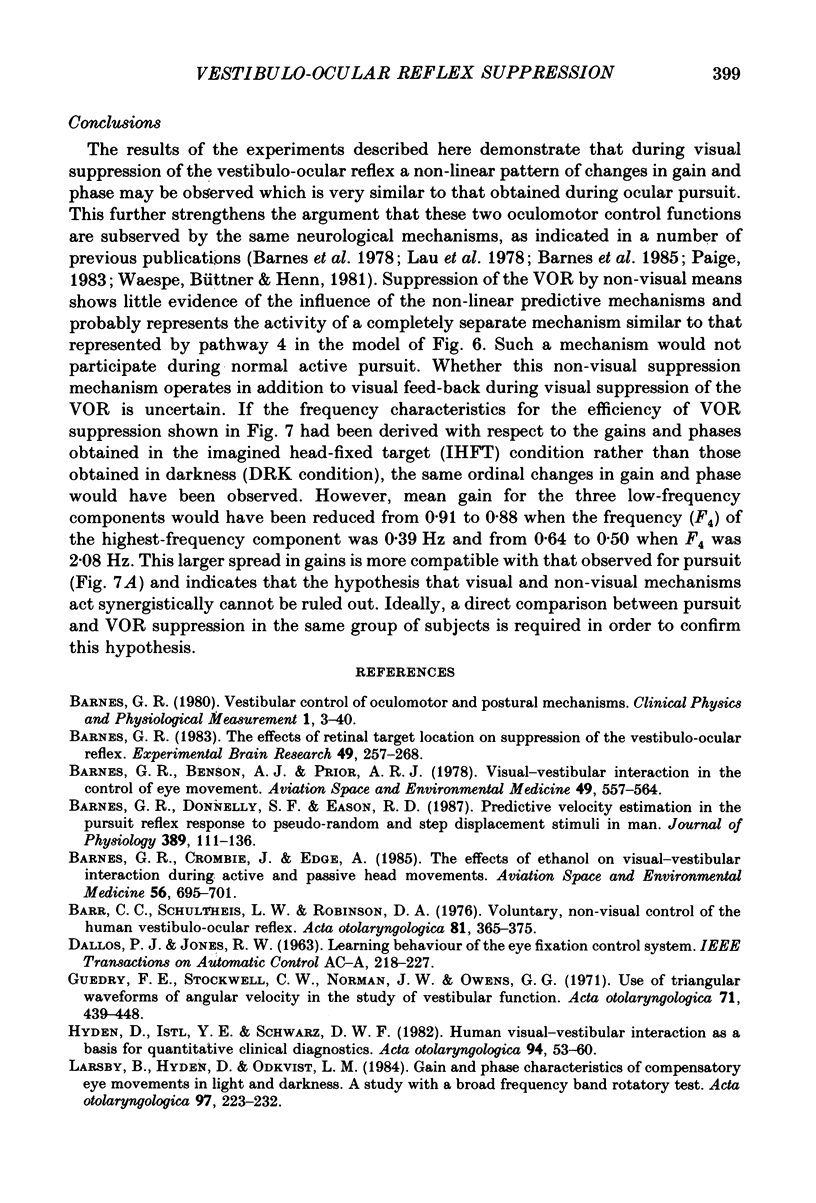
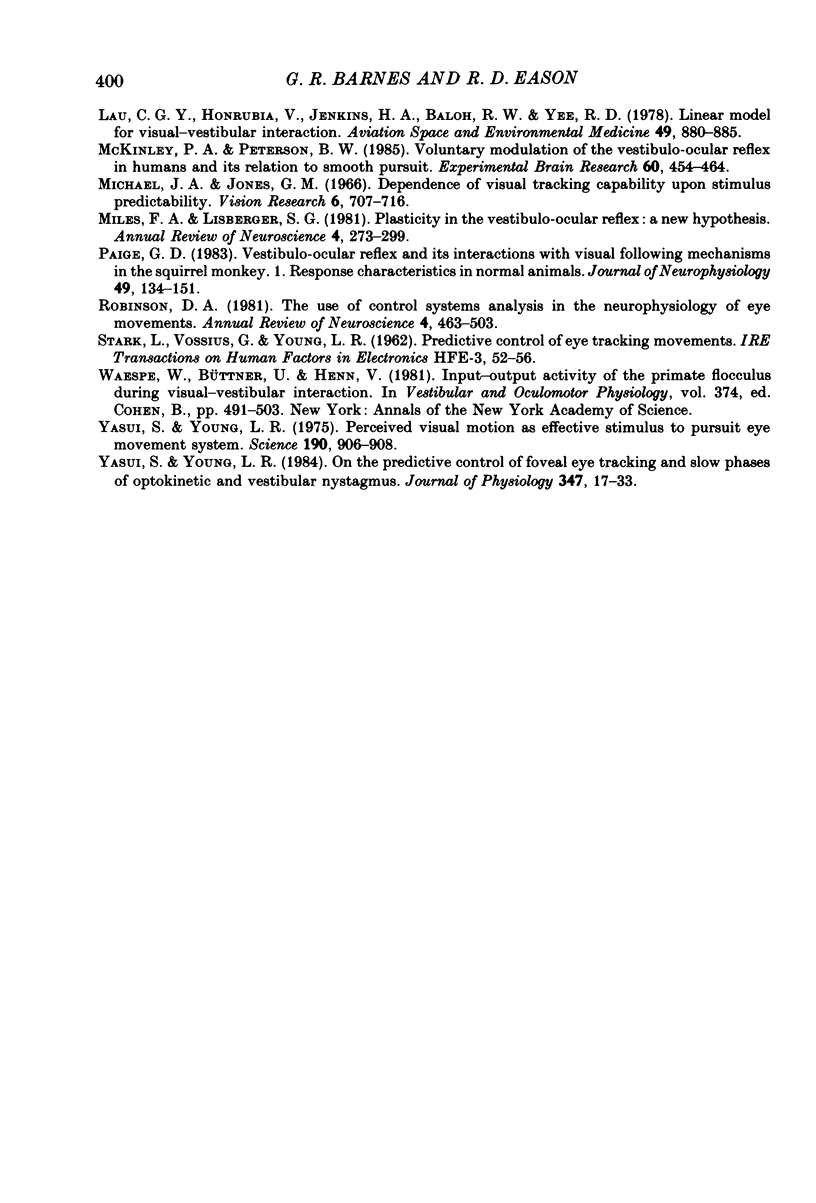
Selected References
These references are in PubMed. This may not be the complete list of references from this article.
- Barnes G. R., Benson A. J., Prior A. R. Visual-vestibular interaction in the control of eye movement. Aviat Space Environ Med. 1978 Apr;49(4):557–564. [PubMed] [Google Scholar]
- Barnes G. R., Crombie J. W., Edge A. The effects of ethanol on visual-vestibular interaction during active and passive head movements. Aviat Space Environ Med. 1985 Jul;56(7):695–701. [PubMed] [Google Scholar]
- Barnes G. R., Donnelly S. F., Eason R. D. Predictive velocity estimation in the pursuit reflex response to pseudo-random and step displacement stimuli in man. J Physiol. 1987 Aug;389:111–136. doi: 10.1113/jphysiol.1987.sp016649. [DOI] [PMC free article] [PubMed] [Google Scholar]
- Barnes G. R. The effects of retinal target location on suppression of the vestibulo-ocular reflex. Exp Brain Res. 1983;49(2):257–268. doi: 10.1007/BF00238585. [DOI] [PubMed] [Google Scholar]
- Barr C. C., Schultheis L. W., Robinson D. A. Voluntary, non-visual control of the human vestibulo-ocular reflex. Acta Otolaryngol. 1976 May-Jun;81(5-6):365–375. doi: 10.3109/00016487609107490. [DOI] [PubMed] [Google Scholar]
- Guedry F. E., Jr, Stockwell C. W., Norman J. W., Owens G. G. Use of triangular waveforms of angular velocity in the study of vestibulbar function. Acta Otolaryngol. 1971 Jun;71(6):439–448. doi: 10.3109/00016487109125387. [DOI] [PubMed] [Google Scholar]
- Hydén D., Istl Y. E., Schwarz D. W. Human visuo-vestibular interaction as a basis for quantitative clinical diagnostics. Acta Otolaryngol. 1982 Jul-Aug;94(1-2):53–60. doi: 10.3109/00016488209128889. [DOI] [PubMed] [Google Scholar]
- Larsby B., Hydén D., Odkvist L. M. Gain and phase characteristics of compensatory eye movements in light and darkness. A study with a broad frequency-band rotatory test. Acta Otolaryngol. 1984 Mar-Apr;97(3-4):223–232. doi: 10.3109/00016488409130983. [DOI] [PubMed] [Google Scholar]
- Lau C. G., Honrubia V., Jenkins H. A., Baloh R. W., Yee R. D. Linear model for visual-vestibular interaction. Aviat Space Environ Med. 1978 Jul;49(7):880–885. [PubMed] [Google Scholar]
- McKinley P. A., Peterson B. W. Voluntary modulation of the vestibuloocular reflex in humans and its relation to smooth pursuit. Exp Brain Res. 1985;60(3):454–464. doi: 10.1007/BF00236931. [DOI] [PubMed] [Google Scholar]
- Michael J. A., Jones G. M. Dependence of visual tracking capability upon stimulus predictability. Vision Res. 1966 Dec;6(12):707–716. doi: 10.1016/0042-6989(66)90082-4. [DOI] [PubMed] [Google Scholar]
- Miles F. A., Lisberger S. G. Plasticity in the vestibulo-ocular reflex: a new hypothesis. Annu Rev Neurosci. 1981;4:273–299. doi: 10.1146/annurev.ne.04.030181.001421. [DOI] [PubMed] [Google Scholar]
- Paige G. D. Vestibuloocular reflex and its interactions with visual following mechanisms in the squirrel monkey. I. Response characteristics in normal animals. J Neurophysiol. 1983 Jan;49(1):134–151. doi: 10.1152/jn.1983.49.1.134. [DOI] [PubMed] [Google Scholar]
- Robinson D. A. The use of control systems analysis in the neurophysiology of eye movements. Annu Rev Neurosci. 1981;4:463–503. doi: 10.1146/annurev.ne.04.030181.002335. [DOI] [PubMed] [Google Scholar]
- Waespe W., Büttner U., Henn V. Input-output activity of the primate flocculus during visual-vestibular interaction. Ann N Y Acad Sci. 1981;374:491–503. doi: 10.1111/j.1749-6632.1981.tb30894.x. [DOI] [PubMed] [Google Scholar]
- Yasui S., Young L. R. On the predictive control of foveal eye tracking and slow phases of optokinetic and vestibular nystagmus. J Physiol. 1984 Feb;347:17–33. doi: 10.1113/jphysiol.1984.sp015050. [DOI] [PMC free article] [PubMed] [Google Scholar]
- Yasui S., Young L. R. Perceived visual motion as effective stimulus to pursuit eye movement system. Science. 1975 Nov 28;190(4217):906–908. doi: 10.1126/science.1188373. [DOI] [PubMed] [Google Scholar]


